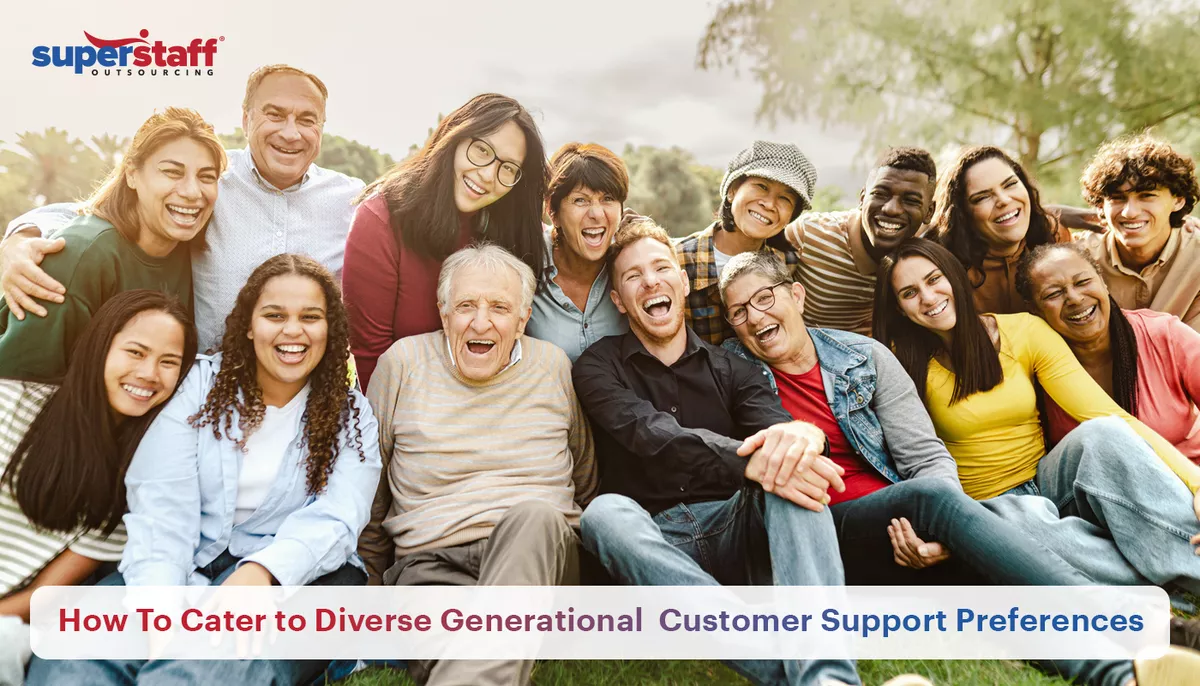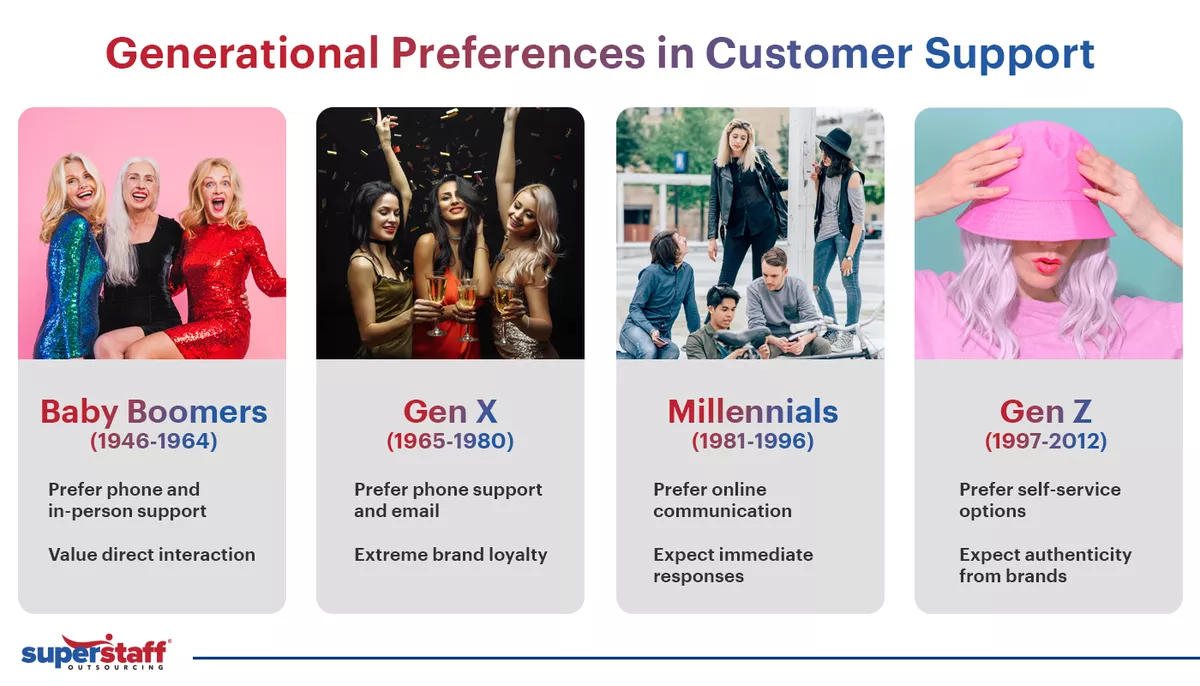
Catering to consumers from all walks of life is crucial for providing exceptional customer support in today’s diverse and dynamic business landscape. Since you’re dealing with buyers of different demographics and backgrounds, your brand must create a customer service strategy that welcomes and addresses everyone’s needs.
One common mistake many companies make is assuming that all age groups approach customer service similarly. The truth is that each generation has its distinct consumer behaviors, preferences, and habits, resulting in vastly different expectations for their chosen brands.
Let’s dive deeper into the differences (and similarities) between generations, including their preferred communication styles and expectations for customer service. Then, we’ll share the critical ingredients for creating a support strategy that resonates across all generations.
Understanding the Different Generational Preferences in Customer Support

Each generation brings unique communication styles, technological familiarity, and expectations. By understanding these preferences, businesses can tailor customer support strategies to create more meaningful and effective customer interactions.
Generational preferences for customer support can vary based on technology adoption, communication styles, and individual preferences.
It’s important to remember that these are general trends, and there are always exceptions. For example, a Gen Z individual might prefer phone calls for complex issues, while a Baby Boomer may feel more comfortable using chat support.
Here’s an overview of generational trends and preferences:
Gen Z
If you were born between 1997 to 2012, you’d be considered part of Generation Z. As of 2023, the Gen Z age range is between 11 to 26.
As the youngest generation in the workforce, Gen Z is the most tech-savvy and socially connected. They embrace innovations while uplifting social causes and ethical practices.
What Is Gen Z Like As a Consumer?
According to HubSpot’s research, phone calls, emails, and live chat are Gen Z buyers’ top three preferred support channels. At the same time, over 1 in 4 have used social media for customer service.
Being the generation born amid the boom of social media, Gen Z customers are accustomed to using digital channels for communication, such as online chats and emails. As such, they are the age group most likely to expect fast and convenient support, having little patience when being put on hold or asking to wait for service.
They are also the generation most likely to use self-service options, sometimes preferring to resolve problems independently instead of contacting customer support agents.
Despite the greater adoption of new technologies, Gen Zers still value the human element of customer support, desiring personalization, authenticity, and a seamless transition between online and offline experiences.
A McKinsey survey found that Gen Z’s core consumer behaviors are rooted in a search for truth. Their generation values individualism, radical inclusivity, ethical consumption, social responsibility, and an overall desire to improve the world.
As such, companies must pay close attention to the brand values and messages they share on social media sites, as Gen Zers are more likely to interact with brands who share their principles.
Millennials
Born between 1981 and 1996, millennials are the largest living generation in the modern age, surpassing baby boomers in 2015.
As of 2023, the millennial age range is between 27 to 42. With over 75 million people in this cohort, they comprise a large portion of the existing global workforce and are among the most massive consumer groups.
One McKinsey study reported that the millennial generation has spent $1 trillion, and analysts expect their spending power to reach $8.3 trillion by 2025, becoming the highest spender of all generations. In contrast, Gen X is estimated to spend $6.4 trillion, while baby boomers spend $1.1 trillion.
What Is a Millennial Like As a Consumer?
According to the research above, 40% of millennials are value-driven consumers, often turning to reviews and peer recommendations before making purchase decisions.
Most millennials came of age at the height of an economic recession, so they may be more discerning when choosing between brands and products, emphasizing value and quality.
Like Gen Z, millennials are digital natives who prefer communication through various online platforms, including social media, chat apps, and email. Having grown up in the age of the internet boom, they appreciate quick responses, are comfortable using a wide range of channels, and feel more inclined toward personalized experiences.
In HubSpot’s 2022 Consumer Trends Report, millennials are most likely to maximize social media use for customer service, with 24% using direct messaging for support.
Gen X
Known as the “middle child generation,” Gen X is generally many businesses’ most overlooked consumer segment. Their generation was born between 1965 and 1980, falling after the baby boomer years but before the millennial age.
What Is Gen X Like As a Consumer?
Gen X tends to lean towards phone and email for customer support. According to the same HubSpot research mentioned above, 46% of Gen X customers ask for help through phone calls, 40% prefer email, and 37% still desire in-person service.
Unlike Gen Z and millennials, Gen X tends to be more patient when asked to wait on hold, still vastly preferring traditional support channels to newer ones like live chat and social media. They also value a personal touch and prefer well-structured, clear communication.
Another noteworthy fact about this generation is their extreme brand loyalty. According to an eMarketer study, more than 4 out of 10 Gen Xers say they stick to brands they like (a much higher number compared to other generations) and are willing to pay a premium for products from their chosen brands.
They are also less inclined to give chances to new brands, unlike other generations. So, if you’ve won the heart of a Gen X customer, you’ll likely keep them for life as long as you keep up with their customer service preferences.
Baby Boomers
Following the “silent generation” but preceding Generation X, baby boomers are the demographic cohort born between 1946 and 1964. They are called the “baby boom generation” because of the significant increase in the number of children born following the end of World War II.
As of this writing, the baby boomers’ age range is between 57 to 75 years old.
Baby boomers are the second largest generational group in U.S. history, surpassed only by millennials. They are also the largest segment of consumers, taking 40% of the total market share. As such, they continue to significantly impact the economy, even as many reach retirement age.
What Are Baby Boomers Like As Consumers?
According to the U.S. News study, baby boomers control 70% of all disposable income in the United States. They are an affluent generation willing to spend money on products and services that add value to their daily lives.
When it comes to customer service, boomers overwhelmingly prefer phone support (55%), followed by email (30%) and in-person service (27%). Although this is a rare occurrence, some also utilize social media and live chat, but they prefer talking to human support agents instead of AI chatbots.
Baby boomers value direct, person-to-person interaction and appreciate clear, detailed explanations. They may also have a higher preference for voice communication over text-based communication.
How Your Customer Support Team Can Create Tailored Strategies That Resonate Across Generations
Meeting customer expectations is crucial to ensuring greater client satisfaction and loyalty. However, it would be best never to assume that all generations would have the exact expectations and preferences.
So, how can you create a customer service strategy that caters to everyone, regardless of age group? Here are a few critical things to get right:
Omnichannel Support
Each generation has distinct preferences for customer service. However, they have a common desire not to be limited by only one support option.
Instead of investing heavily in only one type of customer service channel, the ideal strategy for businesses is adopting omnichannel solutions. Giving clients the option to contact you through multiple channels – phone, email, chat, or social media – can help you address generational preferences and each customer’s needs.
According to Aberdeen Group research, companies prioritizing omnichannel support are likelier to keep 89% of their customers. Meanwhile, brands with weak omnichannel strategies have a much smaller customer retention rate of only 33%.
Investing in omnichannel support solutions allows customers of all generations to reach you wherever they’re most comfortable, helping build better relationships with them and earning their trust and loyalty.
Multilingual Customer Service
In addition to providing seamless support across multiple channels, another strategy to cater to different generations is offering multilingual customer service. According to the Pew Research Center, the Gen Z and Millennial generations in the U.S. are the most racially and ethnically diverse of all living age groups.
Because of increased racial and cultural diversity, many younger-generation Americans speak a language other than English at home. Businesses must remember that not catering to people’s preferred vernacular could prove disastrous, alienating many potential customers.
Check out these eye-opening statistics from Unababel’s Global Multilingual CX Survey:
- 75% of consumers will only spend $500 or less when brands don’t offer multilingual customer service.
- 84% will pay more for a product or service if the company provides native language support.
- 68% would switch to a competitor if a brand does not provide support in their native language.
- 57% consider it a “bias” when brands don’t offer multilingual experiences.
These numbers illustrate the growing need for multilingual support in the United States. At the same time, multilingual customer support can expand your brand beyond your borders and help you enter international markets.
As today’s business landscape becomes increasingly globalized, investing in multilingual solutions could give you a competitive edge that resonates across all generations.
Seamless Processes
Here’s one thing all customers, no matter their age range, have in common: They expect the customer service process to be straightforward without unnecessary obstacles.
According to a 2023 Gartner study, 93% of consumers feel very satisfied when they experience a seamless transition between multiple customer service channels. However, the reality is that 62% say that transitioning between different customer service channels requires “high effort” on their part.
This data illustrates that many businesses are beginning to offer omnichannel support but have not created seamless transitions between each channel. When buyers need help, they want to be able to switch between platforms with ease.
Customers don’t want to repeat themselves after already sharing information with one support agent, and they expect that your team will still have their data and records on hand even when they reach out through a different channel.
Personalized Experiences
Beyond creating seamless multilingual, omnichannel experiences, businesses must level up personalization in their CS strategy. No matter their generation, today’s customers expect companies to tailor their interactions to their needs and preferences.
Take a look at these relevant data and statistics:
- 62% of consumers would turn away from a brand that delivered non-personalized experiences.
- 83% are willing to share their data for a more personalized customer service interaction.
- 66% expect brands to understand their unique needs, preferences, and expectations.
- 89% of companies are increasingly investing in personalization for customer service.
Customers want to feel like their concerns are being listened to and that your company values them and their feedback. When they reach out to you, it’s not just a business interaction; it can feel genuinely personal on their end.
Rapid Response and Resolution Times
In previous sections, we mentioned how younger generations want quick responses to customer service inquiries. One Zendesk study found that 80% of millennials and 64% of Gen Zers expect an instant response from a company when they need support – a stark contrast to older generations willing to wait longer for service.
What all generations have in common, though, is the desire to have their customer service issues resolved as efficiently as possible.
Ideally, businesses should strive to improve their response and resolution times. The goal is to answer questions quickly and provide the most helpful and relevant resolution to the customer’s concern.
Self-Service Options
In the past, customers needed to contact a support rep to get answers and solutions to their most pressing problems. With the rise of search engines, information has never been easier to find for the average person.
Today, customers can simply check your company’s website for self-service options, such as FAQs or knowledge bases, to find ways to solve their problems independently. A Zendesk survey found that 75% of consumers see self-service as a convenient way to address customer service issues, and 67% prefer it to other support channels.
Millennials and Gen Z consumers, in particular, are fans of self-service options, wanting to resolve problems on their own before or instead of contacting customer service. By providing accurate and up-to-date knowledge bases, companies can not only satisfy the preferences of younger generations but also lighten the workload of their service reps, allowing them to focus on more complex and urgent issues.
Data Privacy and Protection
Another expectation that customers across generations share is data privacy and protection. Today’s consumers want brands to use their data for personalization. Still, they want assurance that companies keep their information private and safeguard it from malicious entities.
According to a Pew Research Center survey about data privacy, 79% of Americans say they are not confident that companies will take responsibility for mistakes or potential data misuse. Meanwhile, 69% are unsure whether businesses will use their data for purposes they are comfortable with.
To build customer confidence and loyalty, businesses must be transparent about data collection and assure users that their information is safe and secure. They must also take significant steps to level up their cybersecurity, utilizing innovative ways to prevent, spot, and address potential data breaches.
Outsourced Customer Service
Finally, outsourcing customer service is another strategy businesses can use to create tailored support solutions across generations.
By partnering with a reliable BPO provider, you can access the expertise and experience of offshore customer care professionals. These industry veterans understand that no one-size-fits-all solution exists for customer service. Instead, they will work with you to develop a customized CS strategy that meets your needs.
The right call center can help you streamline your customer service operations, create an integrated and seamless omnichannel experience, and scale your business depending on consumer demand, all while keeping costs low.
Deliver a World-Class Customer Experience That Caters to All Generations
Each generation brings unique expectations and communication styles to the table. By tailoring your customer support solutions to accommodate these differences, you can create a more inclusive and satisfying experience for all your customers.
SuperStaff is a leading BPO firm with a strong presence in the Philippines, the Call Center Capital of the World. We offer various customer service outsourcing solutions, including omnichannel and multilingual support, designed to support and strengthen your existing operations.
Our experienced team is passionate about helping you create a customized CS strategy that caters to all your customers, regardless of their generation or specific demographics. Connect with us today to get started!







